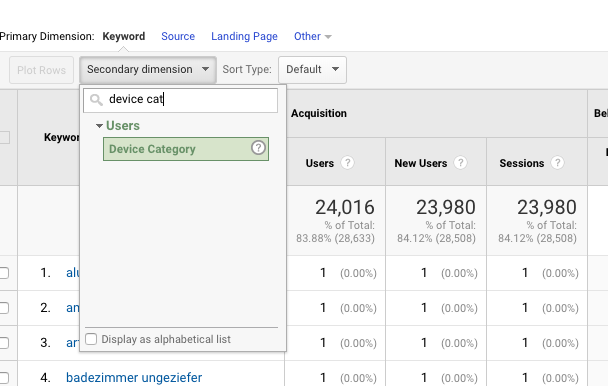Understanding Secondary Dimension in Google Analytics: A Full Overview
Wiki Article
Unlock Deeper Insights With Additional Dimension in Google Analytics
With the vast expanse of data readily available in Google Analytics, the use of second measurements can considerably improve your analytical capacities. These extra layers of data use a nuanced perspective that can light up elaborate details within your primary metrics. By strategically incorporating secondary measurements right into your analysis, you can discover important understandings that might otherwise remain undiscovered. The capability to interpret and dissect individual behavior with better precision opens a realm of possibilities for optimizing strategies and improving performance.Recognizing Key Vs. Secondary Measurements
When analyzing information in Google Analytics, it is vital to identify between key and secondary measurements to get deeper insights into customer behavior. Main measurements are the major categories whereby you can see your data, such as device, source/medium, or landing web page. These dimensions provide the basic structure for arranging and recognizing your information. On the other hand, secondary dimensions permit you to further dissect your key dimension information. By including a secondary dimension, you can layer on extra information to your key dimension, making it possible for an extra granular evaluation. If your key dimension is the source/medium through which users arrived on your site, including a second dimension like geographic area can disclose where those customers are situated geographically. This added layer of details can assist you identify trends, patterns, or abnormalities that may not have actually appeared when taking a look at the main measurement alone. Therefore, leveraging both primary and additional dimensions in Google Analytics is essential for detailed information evaluation and educated decision-making.Making Use Of Secondary Dimensions Properly
By including additional dimensions together with main dimensions, marketers and experts can dig deeper right into the specifics of user communications on their sites. Secondary measurements permit individuals to section and filter primary measurement information even more, using a much more in-depth view of customer interactions, behaviors, and demographics.Moreover, additional measurements allow individuals to contrast and contrast different data factors within a single report, promoting a more thorough evaluation of user habits patterns. By leveraging additional measurements successfully, services can uncover surprise insights, optimize their marketing approaches, and boost the general individual experience on their web sites.
Discovering Common Second Dimension Mixes
To even more evaluate customer behavior and trends in Google Analytics, it is valuable to check out usual mixes of additional measurements. By integrating various second measurements, analysts and marketers can get deeper insights into just how different variables influence and communicate web site efficiency. Some common secondary dimension mixes that supply beneficial insights consist of evaluating traffic sources with user areas to comprehend where site site visitors are coming from geographically and just how they located the website. In a similar way, integrating touchdown web pages with tools can disclose which web pages execute best on various devices, assisting in maximizing the site for better user experience. In addition, examining individual actions metrics with second measurements such as demographics Get the facts or rate of interests can aid in targeting certain audience sections better. By exploring these usual second dimension mixes, organizations can uncover covert patterns, recognize chances for renovation, and make data-driven choices to boost their on-line presence.Using Secondary Dimension in Custom-made News
Making use of second measurements in custom reports enables an extra extensive analysis of information in Google Analytics, improving the depth of insights acquired. When creating custom-made records in Google Analytics, including second dimensions can supply a much more comprehensive view of just how different measurements engage with each various other. This attribute makes it possible for customers to dive deeper right into their information and uncover valuable connections that may not be quickly noticeable.By using second measurements in custom-made reports, customers can acquire a better understanding of great site their site or app traffic. Integrating the primary measurement of "source/medium" with the additional measurement of "touchdown page" can expose which landing pages are performing best for web traffic coming from specific sources. This insight can aid marketers maximize their campaigns and enhance overall conversion rates.

Enhancing Data Visualization With Second Measurement
When exploring data in Google Analytics customized reports, integrating additional dimensions not just offers a more thorough analysis however likewise improves the graph of understandings with information visualization. By adding an additional dimension to your records, you can enhance the here are the findings means data is offered, making it simpler to identify patterns, trends, and connections within your internet site's performance metrics.Secondary dimensions can aid you section your data further, enabling a much deeper understanding of user actions and interactions on your site. This enhanced level of granularity can be specifically valuable when trying to separate specific variables that may influence your site's performance - Secondary Dimension in Google Analytics.

Conclusion
Finally, leveraging second dimensions in Google Analytics permits a more extensive analysis of information, resulting in deeper understandings and more enlightened decision-making. Secondary Dimension in Google Analytics. By adding added layers of details to primary information collections, analysts and marketing experts can discover covert fads, patterns, and relationships that supply a granular view of user actions and interactions. This enhanced degree of understanding allows optimization of campaigns and tailored strategies for certain audience sectors, eventually improving efficiency and conversion pricesOn the other hand, additional dimensions permit you to additional study your main dimension information. By including a second measurement, you can layer on extra information to your key dimension, enabling an extra granular analysis. If your primary measurement is the source/medium through which individuals showed up on your website, adding a second dimension like geographic location can disclose where those customers are situated geographically. By incorporating secondary measurements together with main measurements, experts and marketing professionals can dive deeper right into the specifics of user communications on their websites. Second dimensions permit individuals to segment and filter main dimension information further, offering an extra in-depth view of customer behaviors, interactions, and demographics.
Report this wiki page